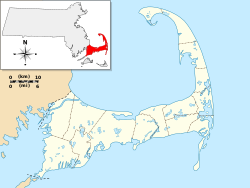William Marston House | |
 | |
| Location | 71 Cotuit Rd., Barnstable, Massachusetts |
|---|---|
| Coordinates | 41°39′8″N70°24′53″W / 41.65222°N 70.41472°W |
| Built | 1780 |
| Architectural style | Georgian |
| MPS | Barnstable MRA |
| NRHP reference No. | 87000234 [1] |
| Added to NRHP | March 13, 1987 |
The William Marston House is a historic house located in the Marstons Mills area of Barnstable, Massachusetts.



